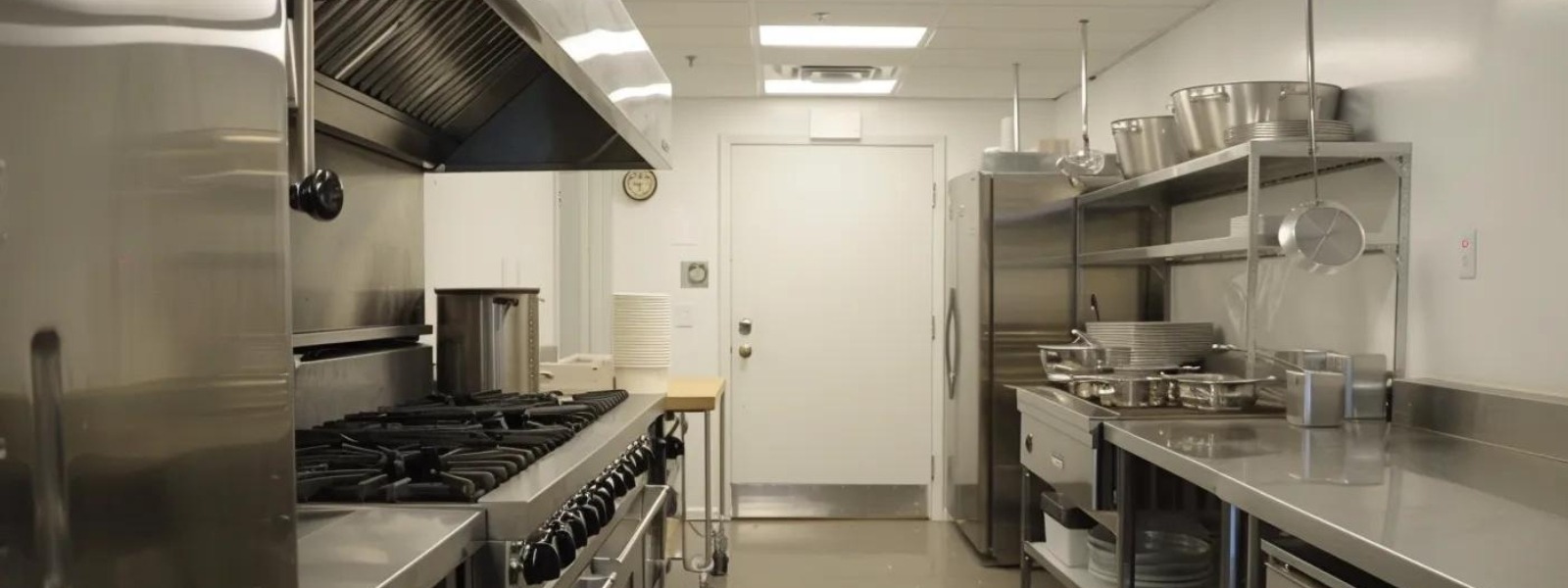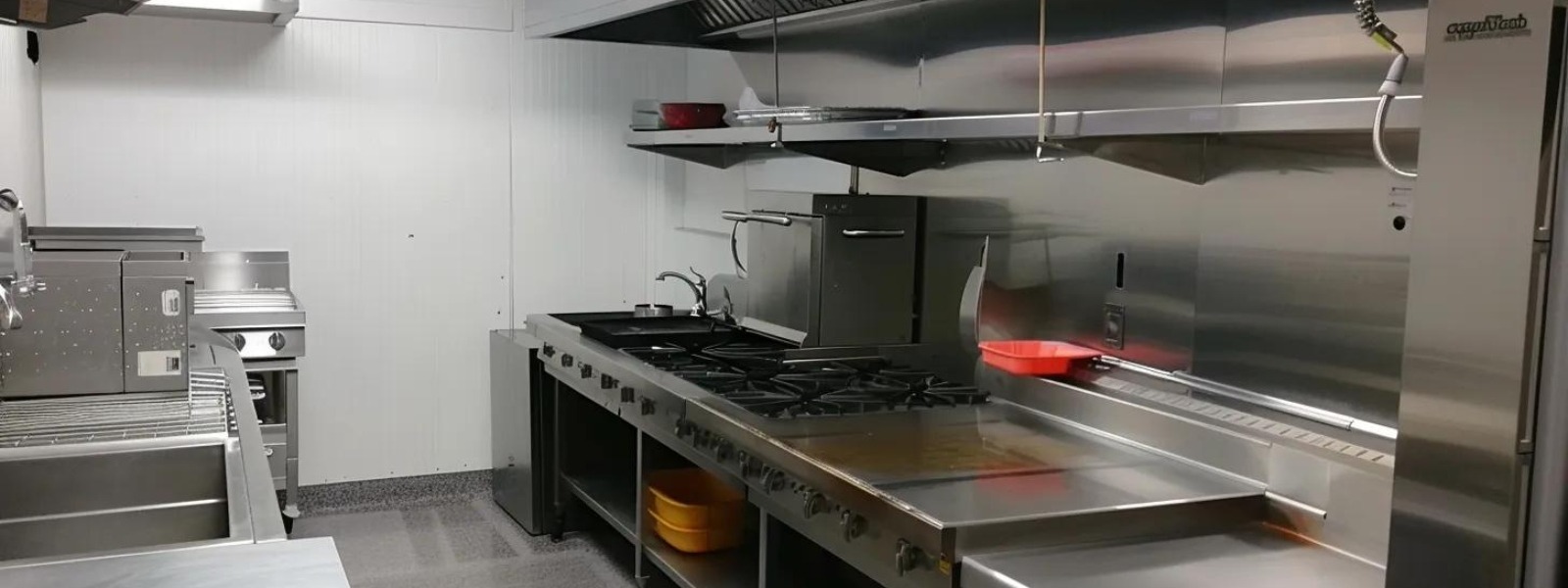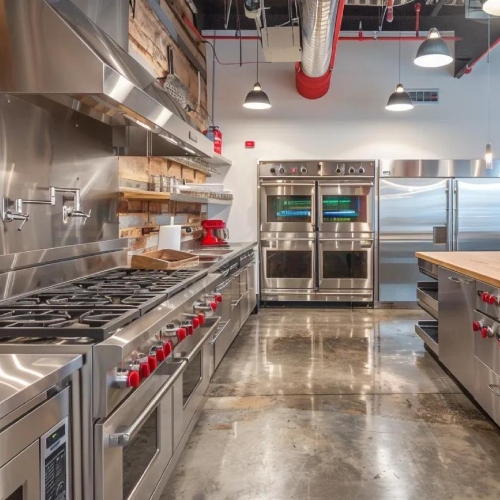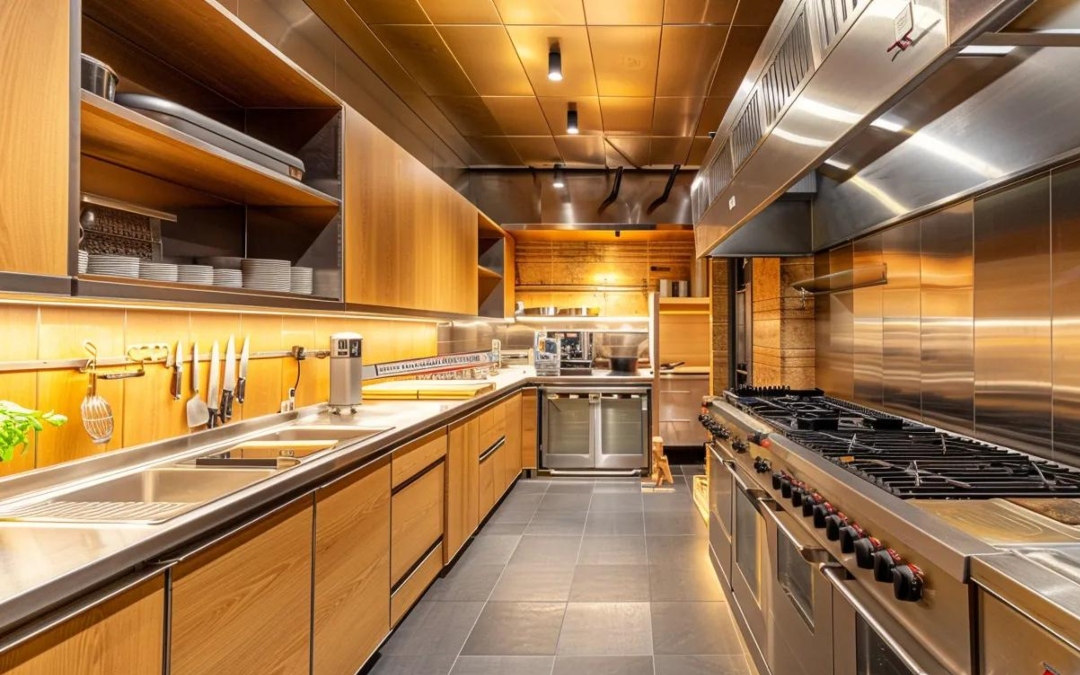Yes, you can convert a garage into a commercial kitchen by obtaining permits, meeting health department standards, and complying with local zoning regulations. The process requires health permits, building permits, building permits, proper equipment, and modifications to plumbing, electrical systems, and ventilation.
Converting a garage into a commercial kitchen costs between $15,000 and $100,000 depending on size, location, and equipment needs. Health departments require specific certifications, NSF-approved equipment, and regular inspections. The timeline from planning to operation typically spans six to eight months. Small-scale food entrepreneurs choose garage conversions to avoid monthly rent payments, maintain flexible schedules, and work from home.
What Is a Commercial Kitchen?
A commercial kitchen is a licensed food preparation space that meets health department standards for producing food sold to the public. Commercial kitchens differ from home kitchens through specialized equipment, separate work zones, commercial-grade appliances, and health code compliance.
Commercial kitchens contain heavy-duty refrigeration units, multi-bay sinks, commercial ovens, ventilation hoods, and NSF-certified equipment. The distinction centers on equipment ratings, ventilation capacity, and sanitation infrastructure. Commercial refrigerators maintain consistent temperatures despite frequent door openings.
Cottage Food Laws allow limited home food production, but garage conversions do not qualify as home kitchens under these regulations. States restrict home kitchen sales to specific products like baked goods, jams, and dried herbs with annual revenue caps between $15,000 and $50,000. Products must be low-risk items that do not require refrigeration.
Does Zoning Allow Commercial Kitchens in Residential Garages?
Zoning laws regulate property use and determine whether residential properties can operate commercial food businesses. Municipal zoning codes classify properties as residential, commercial, industrial, or mixed-use. Most residential zones prohibit commercial operations without special permits.
Contact the local planning department to verify zoning classification. Urban areas enforce stricter zoning restrictions than rural locations due to noise, traffic, and odor concerns. Zoning permits typically cost $1,200 to $2,000 and require approval before building permits. Properties in commercial or mixed-use zones face fewer restrictions.
Conditional use permits allow specific commercial activities in residential zones under certain conditions. Applicants demonstrate minimal neighborhood impact through traffic studies, operational hours limits, and sound mitigation plans. Permit conditions may restrict delivery times, employee numbers, and customer visits. Zoning violations result in cease-and-operate orders, daily fines, and legal action.
Steps to Verify Zoning Compliance
Contact the city or county planning office to request zoning classification documents. Planning staff review property addresses in zoning maps and provide written confirmation of permitted uses. Schedule appointments with zoning administrators to discuss project feasibility. Research zoning ordinances online through municipal websites. Look for home occupation provisions, accessory use regulations, and food service definitions.
What Health Department Requirements Apply?
Health departments require food handler certifications, approved floor plans, proper equipment, and regular inspections for commercial kitchens. Food Safety Certification proves knowledge of contamination prevention, temperature control, and sanitation practices.
Food Handler Cards require three hours of training and remain valid for three years. Certified Food Protection Manager certificates need eight hours of training and last five years. Training covers proper hand washing techniques, safe food temperatures, cross-contamination prevention, and cleaning procedures.
Commercial kitchens fail health inspections at a 23% annual rate. Common violations include improper food storage temperatures, inadequate hand-washing facilities, cross-contamination risks, and insufficient cleaning protocols. Critical violations require immediate correction and can result in facility closure.
Hand-washing sinks must be separate from food preparation and dishwashing sinks. California requires one hand-washing station per nine employees. Sinks need hot and cold running water, soap dispensers, and paper towel holders. Three-compartment sinks serve as dishwashing stations with wash, rinse, and sanitize sections. Mop sinks prevent contaminated water from entering food preparation areas.
Health permits cost $500 to $2,000 annually depending on jurisdiction. Submit detailed floor plans showing equipment placement, work zones, and traffic flow before construction begins. Pre-opening inspections verify that constructed facilities match approved plans. Temperature monitoring logs document refrigerator and freezer performance with daily checks required.
What Building Codes Must Commercial Kitchens Meet?
Building codes specify structural requirements, fire safety systems, electrical capacity, plumbing standards, and ventilation for commercial kitchens. International Building Code and local municipal codes govern commercial kitchen construction. Building departments enforce codes through plan review and construction inspections. Code compliance protects building occupants and neighboring properties.
Fire marshals inspect suppression systems, emergency exits, smoke detectors, and fire extinguisher placement. Some jurisdictions require whole-building sprinkler systems when adding commercial equipment to residential properties. Fire codes separate residential and commercial occupancy classifications with different safety requirements.
Type K fire extinguishers contain special chemicals for grease fires. Water-based extinguishers spread burning grease and worsen fires. Extinguishers must be mounted within 30 feet of cooking equipment. Annual inspections verify proper pressure and functionality. Employees need training in fire extinguisher operation.
Automatic suppression systems protect cooking equipment from grease fires. Systems detect excessive heat and spray fire-suppressing chemicals over cooking surfaces. Suppression systems automatically shut off gas or electricity to cooking equipment. Manual pull stations allow employees to activate systems during emergencies.
Smoke and heat detectors alert occupants to fire conditions. Detectors connect to building alarm systems that notify fire departments. Detector placement follows manufacturer specifications and fire code requirements. Some jurisdictions require monitored alarm systems with central station reporting.
Clear emergency exit paths lead from kitchens to exterior doors. Exit routes cannot pass through residential living spaces. Exit doors must be unlocked during business hours. Exit signs illuminate paths during power outages. Fire-rated doors separate commercial spaces from residential areas.
Commercial cooking equipment generates higher BTU output than residential appliances. Professional ranges produce 25,000 to 60,000 BTUs per burner compared to residential burners at 9,000 to 15,000 BTUs. Higher heat output requires larger ventilation systems and increased fire protection.
Range hoods must provide minimum 700 CFM ventilation with makeup air systems. Makeup air replaces air exhausted through ventilation hoods. Without makeup air, buildings develop negative pressure that affects HVAC performance and door operation. Makeup air can be conditioned or unconditioned depending on climate.
Grease ducts require professional cleaning every three to six months. Accumulated grease in ducts creates fire hazards. Cleaning companies provide certificates of service for insurance and health department records. Access panels in duct systems allow thorough cleaning.
Electrical System Upgrades

Residential electrical panels typically provide 200-amp service. Commercial kitchens need 400-amp or higher capacity for multiple appliances. Each major appliance requires dedicated circuits including refrigerators, ovens, dishwashers, and ventilation systems. Electrical loads are calculated based on equipment nameplates and code requirements.
Licensed electricians must install commercial wiring following National Electrical Code standards. Electrical contractors obtain permits for all work. Inspectors verify proper wire sizing, circuit protection, and grounding. Some jurisdictions require three-phase electrical service for commercial kitchens.
GFCI outlets protect against electrical shock near water sources. GFCI protection is required within six feet of sinks. Ground fault protection detects current imbalances and shuts off power within milliseconds. Regular testing confirms GFCI functionality.
Emergency lighting provides visibility during power outages. Battery-backup systems illuminate exit paths for minimum 90 minutes. Emergency lights must be tested monthly with results documented. Some jurisdictions require generator backup for refrigeration systems.
Electrical panels need proper clearances for access and maintenance. Panels cannot be located in food storage areas. Panel covers must be labeled showing circuit purposes. Some kitchens install subpanels near equipment areas for convenient access.
Plumbing Code Compliance
Commercial kitchen plumbing requires larger supply lines than residential systems. Standard residential plumbing uses half-inch to five-eighths-inch pipes. Commercial kitchens need three-quarter-inch to one-inch supply lines for adequate water pressure. Multiple fixtures operating simultaneously demand higher flow rates.
Grease traps capture cooking oils before entering sewer systems. Cities mandate in-ground grease traps ranging from 500 to 1,500 gallons. Grease trap installation costs $2,000 to $5,000 depending on size and accessibility. Above-ground grease interceptors serve smaller operations with lower grease production.
Grease traps require regular pumping to prevent backups and odors. Service frequency depends on production volume and trap size. High-volume operations pump traps monthly. Smaller operations schedule quarterly service. Service companies provide manifests documenting waste disposal.
Three-bay sinks need hot water heaters providing 120°F minimum temperature. Tankless water heaters supply continuous hot water for high-demand operations. Tank-type water heaters must be sized for peak usage periods. Recovery rates determine how quickly heaters can reheat water.
Backflow preventers stop contaminated water from entering clean water supplies. Cross-connection control programs require annual backflow preventer testing. Certified testers inspect and certify devices. Test reports are filed with water departments.
Floor drains remove cleaning water and prevent flooding. Drains must be large enough to handle equipment cleaning and emergency water flows. Trench drains along equipment rows collect spills efficiently. All drains need trap primers preventing sewer gas entry.
Water treatment systems may be required for well water sources. Bacteria testing confirms water safety. Iron and sulfur removal systems improve water quality. Ultraviolet sterilizers kill microorganisms. Water softeners prevent scale buildup in equipment.
How Much Does Garage Conversion Cost?
Converting a garage into a commercial kitchen costs $15,000 to $100,000 based on size, equipment quality, and construction complexity. Small kitchens with basic equipment cost $15,000 to $30,000. Large operations with commercial-grade appliances and walk-in coolers exceed $50,000.
Electrical upgrades represent major expense categories. Upgrading main service panels costs $2,000 to $8,000. Licensed electrician labor rates range from $75 to $150 per hour. Plumbing installation varies based on distance from existing water lines with plumbers charging $45 to $150 per hour.
Flooring selection impacts both initial costs and long-term maintenance. Quarry tile costs $10 to $20 per square foot installed. Sealed concrete costs $3 to $8 per square foot. Commercial vinyl tile ranges from $5 to $12 per square foot.
Ventilation hood systems represent significant investments. Basic hoods start at $2,000 while complete packages with suppression systems range from $5,000 to $15,000. Fire suppression systems cost $3,000 to $8,000 installed.
Equipment Expenses
NSF-certified equipment costs more than residential appliances but meets health code requirements. Used commercial equipment reduces initial investment by 40% to 60%. Commercial refrigerators range from $1,500 to $5,000 depending on size. Freezers cost $1,200 to $4,000 for reach-in models. Commercial ranges and ovens range from $2,000 to $8,000. Prep tables cost $300 to $1,000 each. Walk-in coolers cost $5,000 to $15,000 installed. Commercial dishwashers range from $2,000 to $8,000.
What Construction Steps Does Conversion Require?
Garage conversion follows a sequence including permitting, demolition, framing, utilities installation, insulation, finishes, and equipment setup. Timeline spans two to eight months depending on project scope and contractor availability.
Phase 1: Planning and Permits
Submit architectural drawings to building departments showing all construction details. Floor plans indicate equipment placement, electrical outlets, plumbing fixtures, and ventilation ducts. Building departments review plans for code compliance against adopted building codes. Corrections and revisions extend approval time. Health departments review kitchen layouts verifying adequate hand-washing facilities, proper sink configurations, and appropriate equipment spacing.
Permit approval takes four to twelve weeks in most jurisdictions. Rush processing may be available for additional fees. Complex projects require longer review periods.
Phase 2: Demolition and Framing
Remove garage doors, tracks, and opener mechanisms from openings. Install framing for new walls covering garage door openings using two-by-four or two-by-six lumber. Add windows for natural light and emergency egress. Install R-13 to R-15 fiberglass batts in walls with ceiling insulation at R-30 to R-38. Frame dropped ceilings at eight feet for easier climate control.
Phase 3: Utilities Installation
Licensed contractors rough-in electrical wiring, plumbing pipes, and gas lines meeting code requirements. Install electrical panel upgrades providing adequate service capacity. Run hot and cold water supply lines to sink locations with water pressure at 40 to 80 PSI at fixtures. Ventilation hood installation requires rooftop or exterior wall penetrations.
Rough-in inspections verify proper installation before covering work. Inspectors check pipe sizing, support methods, and code compliance.
Phase 4: Wall and Floor Finishes
Commercial kitchens require washable wall surfaces. FRP panels cost $3 to $8 per square foot installed. Ceramic tile ranges from $8 to $20 per square foot installed. Garage floor levels sit four to eight inches below house floors. Pour self-leveling concrete to match elevations costing $2 to $5 per square foot. Floors pitch toward drains at one-quarter inch per foot minimum.
Phase 5: Equipment and Final Inspection
Install custom cabinetry, shelving, and storage solutions maximizing space efficiency. Set commercial equipment following manufacturer specifications. Level refrigerators for proper operation and allow proper clearances around equipment.
Schedule final inspections with building department, fire marshal, and health department verifying code compliance. Address any deficiencies before receiving operating permits.
What Equipment Does a Commercial Kitchen Need?

Commercial kitchens require NSF-certified refrigeration, cooking equipment, prep surfaces, sinks, and storage meeting health code standards. NSF International certifies equipment meets sanitation and safety standards through independent testing. Equipment selection depends on food products and production volume.
Commercial refrigerators use heavy-duty compressors running continuously. Prep tables need stainless steel surfaces facilitating easy cleaning. Storage shelving must sit six inches off floors allowing cleaning access underneath. Small equipment includes mixers, food processors, scales, and thermometers supporting food production.
What Insurance Protects Commercial Kitchen Operations?
Commercial kitchen insurance includes general liability, product liability, property coverage, and workers' compensation policies protecting against financial losses. General liability protects against injuries occurring on the property. Product liability covers foodborne illness claims and allergic reactions.
Standard homeowners insurance excludes commercial activities from coverage. Business owners need commercial property insurance providing appropriate protection. Workers' compensation insurance becomes mandatory when hiring employees with rates at $2 to $4 per $100 of payroll. Product recall insurance covers costs of removing contaminated products from distribution channels.
Business interruption insurance replaces lost income during equipment failures or facility repairs. Annual insurance costs range from $2,000 to $8,000 depending on coverage limits and business size.
What Are Common Conversion Problems?
Common problems include zoning denials, failed health inspections, insufficient utilities, cost overruns, and neighbor complaints requiring careful planning. Research and planning prevent most issues. Professional contractors with commercial kitchen experience avoid common mistakes.
Zoning rejection stops projects before construction begins. Appeals processes allow challenging adverse decisions. Variance applications request exceptions to zoning restrictions. Failed health inspections delay opening dates. Missing hand-washing sinks, improper sink configurations, and inadequate lighting cause failures.
Utility capacity problems include insufficient electrical service and inadequate water pressure. Electrical service upgrades cost $2,000 to $8,000. Water pressure below 40 PSI requires booster pumps. Cost overruns average 15% to 25% above initial estimates. Maintain contingency budgets of 20% for unforeseen expenses.
Neighbor complaints create tensions through delivery trucks blocking streets, noise from equipment, and cooking odors. Keep noise down by maintaining equipment properly. Maintain property appearance matching neighborhood standards.
How Long Does Conversion Take?
Garage conversion takes six to eight months from initial planning through final inspections and permit issuance. Permit approval requires four to twelve weeks depending on jurisdiction workload. Construction spans eight to sixteen weeks depending on project scope. Equipment with long lead times should be ordered during permit review periods. Custom fabrication for hoods and specialized appliances takes six to twelve weeks.
What Ongoing Costs Apply?
Operating costs include utilities, maintenance, permits, insurance, and compliance expenses totaling thousands annually. Commercial kitchen utilities cost two to three times residential rates. Electricity powers refrigeration, cooking equipment, ventilation, and lighting with monthly costs from $300 to $800. Water and sewer charges range from $100 to $300 monthly. Natural gas costs range from $150 to $400 monthly.
Waste removal costs range from $100 to $250 monthly. Pest control costs range from $50 to $150 monthly. Grease trap pumping costs $150 to $300 quarterly. Health permit renewals cost $500 to $2,000 annually. Insurance premiums cost $2,000 to $8,000 annually. Equipment maintenance costs $1,000 to $3,000 annually.
Can Commercial Kitchens Return to Garages?
Commercial kitchens can be converted back to garages by reversing construction modifications and restoring vehicle storage functionality. Preserve garage door components behind new walls facilitating future restoration. Converting back eliminates business tax deductions previously claimed. Custom garage cabinetry can help organize storage whether for business or personal use.
What Alternatives Exist to Garage Conversion?
Alternatives include renting commissary kitchens, using shared commercial spaces, or building detached structures providing commercial kitchen functionality. Commissary kitchens rent by the hour for $15 to $50 providing fully equipped facilities. Shared kitchen spaces offer equipment access without long-term lease obligations.
Renting commercial space costs $500 to $3,000 monthly. Commercial properties include established utilities, health department approval, and professional environments. Building new detached structures avoids residential code conflicts allowing pure commercial construction.
Cottage Food Laws allow limited home kitchen production for specific low-risk products. Examples include cookies, bread, granola, and dried herbs. States limit annual sales from $15,000 to $50,000 under cottage food exemptions. Some entrepreneurs start with cottage food production testing markets before investing in commercial facilities.
What Do People Ask About Garage Commercial Kitchens?
How Long Does It Take to Convert a Garage Into a Commercial Kitchen?
Garage conversion takes six to eight months from initial planning through final inspections. Permit approval requires four to twelve weeks. Construction spans eight to sixteen weeks. Equipment ordering should occur during permit review. Health department inspections happen after construction completion.
Can I Convert My Garage Back Later?
Yes, garages can be converted back by reversing construction modifications and restoring vehicle storage functionality. Preserve garage door components behind new walls. Store door tracks, springs, and opener mechanisms for future use. Some property owners maintain dual functionality with removable partitions.
Do I Need a Bathroom in My Commercial Kitchen?
Bathroom requirements depend on local codes and employee numbers. Facilities without employees may not require separate bathrooms. Health departments typically require hand-washing sinks separate from food preparation areas. Some jurisdictions mandate restroom facilities when employees work on site.
Can I Live in the Same House With a Commercial Kitchen?
Yes, many food entrepreneurs operate commercial kitchens in homes with proper separation. Health departments require physical barriers between residential and commercial spaces. Separate outside entrances prevent family members from entering commercial areas. Some jurisdictions require dedicated bathroom facilities for commercial operations.
What Happens If My City Won't Allow Commercial Kitchens?
Property owners can apply for zoning variances, conditional use permits, or rent alternative spaces. Variance applications request exceptions to zoning restrictions. Conditional use permits allow commercial activities under operational limitations. Alternative options include renting commissary kitchens or purchasing commercial properties.
Final Thoughts
Converting garages into commercial kitchens requires permits, health approvals, substantial investment, and code compliance protecting public safety. Costs range from $15,000 to $100,000 depending on project scope and location. Timeline spans six to eight months from planning through operation. Success depends on thorough planning, professional contractors, and regulatory cooperation.
Check zoning regulations before starting any work avoiding expensive mistakes. Meet with health departments understanding specific requirements for food type and production volume. Budget for construction costs plus 20% contingency covering unexpected expenses. Obtain proper insurance coverage protecting business operations from liability claims.
Working with experienced contractors familiar with commercial kitchen codes prevents costly mistakes and delays. Commercial cabinetry services design efficient storage solutions maximizing workspace functionality. Professional installation provides years of reliable service supporting business growth.







